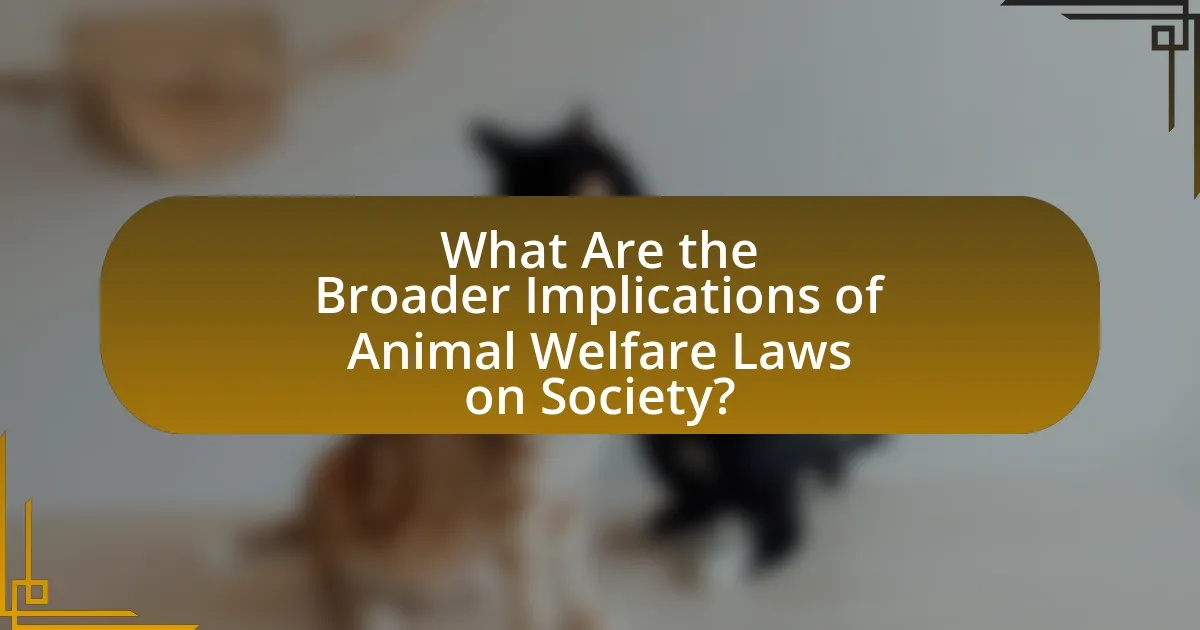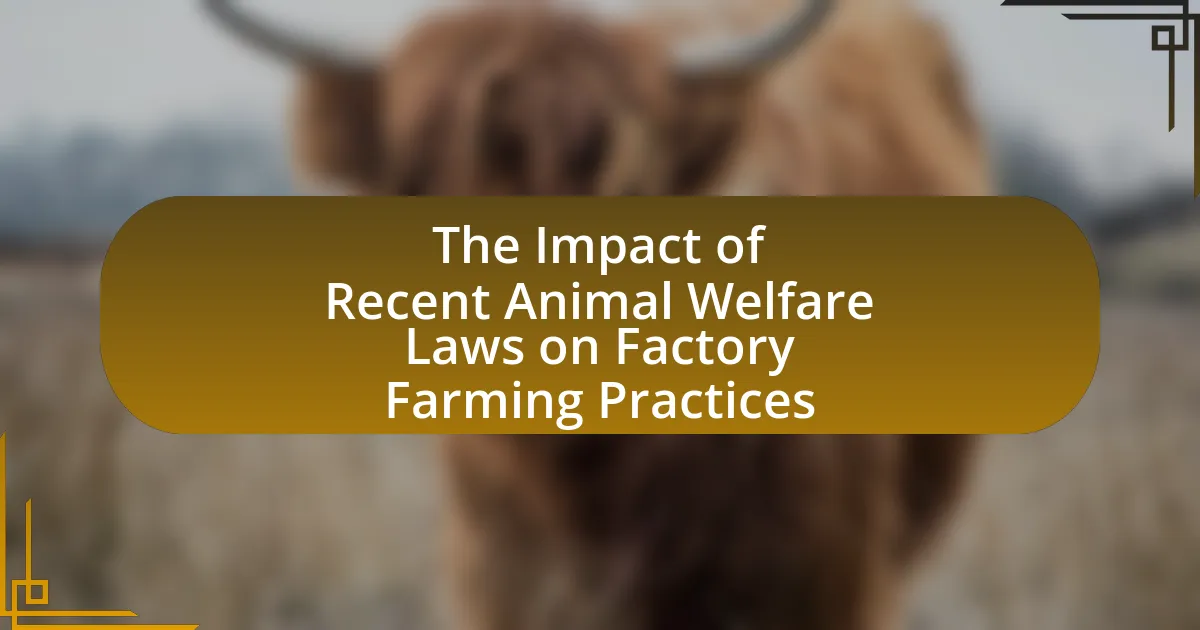The article examines the impact of recent animal welfare laws on factory farming practices, highlighting key regulations such as California’s Proposition 12 and the European Union’s Animal Welfare Regulation. It discusses how these laws aim to improve the treatment and living conditions of farm animals by mandating adequate space, humane handling, and better nutrition. The article also explores the challenges faced by factory farms in complying with these regulations, including increased operational costs and logistical adjustments, while emphasizing the broader societal implications, such as shifts in consumer behavior and public perception of factory farming. Additionally, it outlines best practices for farms to balance profitability with ethical standards in animal welfare.

What are Recent Animal Welfare Laws and Their Purpose?
Recent animal welfare laws aim to enhance the treatment and living conditions of animals, particularly in agricultural settings. These laws, such as the Animal Welfare Act amendments and various state-level initiatives, focus on reducing cruelty, ensuring adequate space, and improving overall welfare standards for farm animals. For instance, California’s Proposition 12 mandates that egg-laying hens, pigs, and calves have sufficient space to move freely, reflecting a growing trend towards more humane farming practices. Such regulations are designed to address public concerns about animal suffering and promote ethical treatment in factory farming.
How do these laws impact factory farming practices?
Recent animal welfare laws significantly impact factory farming practices by imposing stricter regulations on the treatment of animals. These laws often require improved living conditions, such as larger space allowances and access to outdoor areas, which directly affect how factory farms operate. For instance, California’s Proposition 12 mandates that egg-laying hens must have at least 1 square foot of space each, leading many farms to alter their housing systems to comply. This shift can increase operational costs and influence production methods, pushing some farms to adopt more humane practices or face penalties.
What specific regulations have been introduced in recent years?
Recent years have seen the introduction of several specific animal welfare regulations aimed at improving conditions in factory farming. Notably, the European Union implemented the Animal Welfare Regulation (EU) 2016/429, which enhances animal health and welfare standards across member states. Additionally, California passed Proposition 12 in 2018, mandating more space for breeding pigs, egg-laying hens, and veal calves, which took effect in 2022. These regulations reflect a growing trend towards stricter animal welfare standards, as evidenced by increased public awareness and advocacy for humane treatment of farm animals.
Why are these laws considered necessary for animal welfare?
These laws are considered necessary for animal welfare because they establish minimum standards for the treatment and care of animals in various industries, particularly in factory farming. Such regulations aim to prevent cruelty, ensure humane living conditions, and promote the physical and psychological well-being of animals. For instance, the Animal Welfare Act in the United States sets guidelines for the humane treatment of animals used in research, exhibition, and as pets, reflecting a societal commitment to protecting animal rights. Additionally, studies have shown that improved animal welfare practices can lead to better health outcomes for livestock, which in turn can enhance food safety and quality for consumers.
What are the key principles behind animal welfare laws?
The key principles behind animal welfare laws include the prevention of suffering, provision of adequate living conditions, and recognition of the intrinsic value of animals. These laws aim to ensure that animals are treated humanely, which is supported by the Five Freedoms framework established by the Farm Animal Welfare Council. This framework emphasizes freedom from hunger and thirst, discomfort, pain, injury, and disease, as well as the freedom to express normal behavior and to be free from fear and distress. The implementation of these principles is crucial for promoting ethical treatment in various contexts, including factory farming, where conditions can often lead to significant animal suffering.
How do these principles apply to factory farming?
The principles of animal welfare laws apply to factory farming by mandating improved living conditions and treatment of animals. These laws require that animals in factory farms be provided with adequate space, proper nutrition, and access to veterinary care, which directly impacts the operational practices of these facilities. For instance, the implementation of the Animal Welfare Act in the United States has led to increased scrutiny and regulation of factory farming practices, resulting in changes such as the reduction of overcrowding and the enhancement of animal handling procedures. Studies have shown that adherence to these principles can lead to better health outcomes for animals, which in turn can improve the quality of meat and dairy products produced, thereby benefiting both consumers and producers.
What ethical considerations are involved in animal welfare legislation?
Animal welfare legislation involves several ethical considerations, primarily the moral obligation to prevent suffering and ensure humane treatment of animals. These ethical considerations include the recognition of animals as sentient beings capable of experiencing pain and distress, which necessitates legal protections against inhumane practices. Additionally, there is an ethical imperative to balance human interests, such as agricultural productivity, with the welfare of animals, promoting practices that minimize harm while allowing for sustainable farming. The ethical framework is often informed by philosophical theories, such as utilitarianism, which advocates for the greatest good for the greatest number, and rights-based approaches that emphasize the intrinsic value of animal life. These considerations are critical in shaping effective legislation that addresses both animal welfare and societal needs.

How Have Recent Animal Welfare Laws Changed Factory Farming Operations?
Recent animal welfare laws have significantly altered factory farming operations by mandating improved living conditions for livestock. These laws often require more space, better access to outdoor environments, and enhanced veterinary care, which directly impacts how farms are structured and managed. For instance, California’s Proposition 12, enacted in 2018, mandates that egg-laying hens must have at least 1 square foot of space per bird, leading many producers to invest in larger facilities or alternative farming methods. Additionally, the European Union’s regulations on animal welfare have prompted a shift towards cage-free systems, affecting production costs and supply chains. These legislative changes reflect a growing societal demand for humane treatment of animals, compelling factory farms to adapt their practices to comply with new standards.
What modifications have factory farms made in response to these laws?
Factory farms have implemented several modifications in response to recent animal welfare laws, primarily by enhancing living conditions for animals. These modifications include increasing space allowances per animal, transitioning to group housing systems for sows, and improving ventilation and lighting in facilities. For example, the introduction of laws mandating more space for gestating sows has led many farms to adopt group housing instead of traditional individual stalls, which has been shown to reduce stress and improve animal welfare. Additionally, some farms have invested in better environmental controls to meet regulations on air quality and temperature, thereby ensuring a healthier living environment for livestock. These changes reflect a broader trend towards compliance with animal welfare standards while also addressing consumer demand for ethically produced food.
How have housing conditions for animals been affected?
Housing conditions for animals have improved due to recent animal welfare laws that mandate more space and better living environments. For instance, legislation such as California’s Proposition 12 requires that farm animals be housed in conditions that allow for natural behaviors, leading to increased space requirements for pigs, chickens, and cows. This shift has resulted in a reduction of overcrowding in factory farms, which historically led to stress and health issues among animals. Studies indicate that these laws have prompted many producers to adopt more humane practices, thereby enhancing the overall welfare of animals in agricultural settings.
What changes have been implemented in feeding and care practices?
Recent animal welfare laws have led to significant changes in feeding and care practices within factory farming. These changes include the implementation of more humane feeding methods, such as the transition from conventional cages to enriched environments that allow for natural behaviors. For instance, the European Union’s Directive 98/58/EC mandates that animals must have access to a diet that meets their nutritional needs, promoting better health and welfare. Additionally, regulations now require more space per animal, reducing stress and aggression, which has been shown to improve overall animal well-being. These adjustments reflect a growing recognition of the importance of animal welfare in agricultural practices.
What challenges do factory farms face due to these laws?
Factory farms face significant challenges due to recent animal welfare laws, primarily in the form of increased operational costs and compliance requirements. These laws often mandate improved living conditions for animals, which can lead to higher expenses for housing, feeding, and healthcare. For instance, the implementation of space requirements for livestock can reduce the number of animals that farms can raise, directly impacting their profitability. Additionally, the need for regular inspections and adherence to stricter regulations can strain resources and require investments in training and infrastructure. According to a report by the Animal Welfare Institute, compliance with these laws can increase costs by up to 20%, making it difficult for some factory farms to maintain their previous levels of production and profitability.
How do compliance costs impact farm profitability?
Compliance costs negatively impact farm profitability by increasing operational expenses, which can reduce net income. For instance, the implementation of recent animal welfare laws often requires farmers to invest in new facilities, equipment, or practices to meet regulatory standards. A study by the Food and Agriculture Organization found that compliance costs can account for up to 20% of total production costs for some farms. This financial burden can lead to decreased profit margins, making it challenging for farmers to sustain their operations, especially smaller farms that may lack the capital to absorb these additional costs.
What are the logistical challenges of implementing new practices?
The logistical challenges of implementing new practices in factory farming due to recent animal welfare laws include the need for significant changes in infrastructure, training of personnel, and supply chain adjustments. These challenges arise because existing facilities may not be designed to accommodate new space requirements for animal welfare, such as larger enclosures or outdoor access. Additionally, staff must be trained to adhere to new protocols, which can lead to temporary disruptions in operations. Supply chains may also need to be restructured to source compliant materials and equipment, further complicating the implementation process. For instance, a study by the Animal Welfare Institute highlights that compliance with new regulations often requires substantial financial investment and time, which can strain resources and affect productivity.

What Are the Broader Implications of Animal Welfare Laws on Society?
Animal welfare laws have significant broader implications on society, primarily by influencing ethical standards, public health, and economic practices. These laws promote humane treatment of animals, which can lead to increased public awareness and shifts in consumer behavior towards more ethical food choices. For instance, a study by the American Society for the Prevention of Cruelty to Animals (ASPCA) indicates that states with stronger animal welfare laws report higher consumer demand for humane products, reflecting a societal shift towards compassion and ethical consumption. Additionally, improved animal welfare can enhance public health by reducing the risks associated with factory farming practices, such as the spread of zoonotic diseases. Economic implications also arise as businesses adapt to comply with these laws, often leading to increased operational costs but potentially higher market prices for ethically sourced products. Thus, animal welfare laws not only reshape societal values but also impact health and economic dynamics within communities.
How do these laws influence consumer behavior and preferences?
Recent animal welfare laws significantly influence consumer behavior and preferences by increasing awareness and concern for ethical treatment of animals. These laws often lead consumers to prefer products that are certified as humane or ethically sourced, as evidenced by a 2021 survey from the American Society for the Prevention of Cruelty to Animals, which found that 70% of respondents were more likely to purchase products from companies that adhere to higher animal welfare standards. Consequently, businesses are adapting their practices to meet these consumer demands, resulting in a shift towards more humane farming methods and transparency in sourcing.
What trends are emerging in consumer demand for ethically sourced products?
Consumer demand for ethically sourced products is increasingly characterized by a preference for transparency, sustainability, and animal welfare. Recent surveys indicate that 66% of global consumers are willing to pay more for sustainable brands, reflecting a growing awareness of ethical sourcing practices. Additionally, the rise of social media has amplified consumer voices, leading to greater scrutiny of brands’ supply chains and ethical claims. This trend is further supported by the implementation of recent animal welfare laws, which have heightened consumer expectations for humane treatment of animals in food production. As a result, companies are adapting by enhancing their ethical sourcing policies to meet this demand, thereby influencing factory farming practices.
How do animal welfare laws affect public perception of factory farming?
Animal welfare laws significantly influence public perception of factory farming by increasing awareness and concern for animal treatment. These laws often highlight the ethical implications of intensive farming practices, leading consumers to question the morality of such systems. For instance, studies show that regions with stricter animal welfare regulations tend to have a more informed public that is critical of factory farming methods, as evidenced by a 2020 survey from the Animal Welfare Institute, which found that 70% of respondents supported stronger animal welfare laws. This growing awareness can lead to shifts in consumer behavior, such as increased demand for humane products and a decline in support for factory-farmed goods.
What role do advocacy groups play in shaping animal welfare laws?
Advocacy groups play a crucial role in shaping animal welfare laws by raising public awareness, influencing policymakers, and mobilizing community support. These organizations often conduct research, provide expert testimony, and engage in lobbying efforts to promote legislative changes that enhance animal protection. For instance, the Humane Society of the United States has successfully advocated for laws that ban certain cruel practices in factory farming, such as gestation crates for pigs, leading to significant legal reforms in multiple states. Their efforts are supported by public campaigns that highlight the ethical treatment of animals, which can sway public opinion and pressure legislators to act.
How do these groups influence legislation and public opinion?
Animal welfare advocacy groups influence legislation and public opinion by mobilizing public support, conducting research, and lobbying policymakers. These organizations often raise awareness about animal rights issues through campaigns that highlight the conditions in factory farming, which can lead to increased public concern and demand for legislative changes. For example, the Humane Society of the United States successfully lobbied for Proposition 12 in California, which sets stricter standards for the confinement of farm animals, reflecting how advocacy can translate into law. Additionally, studies show that public opinion shifts in favor of animal welfare can lead to more stringent regulations, as seen in the growing number of states adopting similar laws following successful campaigns.
What strategies do they use to promote animal welfare?
Organizations promoting animal welfare employ various strategies, including legislative advocacy, public education campaigns, and partnerships with farmers. Legislative advocacy involves lobbying for stronger animal welfare laws, such as the Animal Welfare Act, which sets standards for the treatment of animals in various industries. Public education campaigns raise awareness about animal rights and the conditions in factory farming, influencing consumer behavior and encouraging humane practices. Partnerships with farmers focus on implementing humane farming practices, providing resources and training to improve animal care. These strategies collectively aim to enhance the welfare of animals in agricultural settings and beyond.
What best practices can factory farms adopt to comply with animal welfare laws?
Factory farms can adopt several best practices to comply with animal welfare laws, including providing adequate space, ensuring proper nutrition, and implementing humane handling procedures. Adequate space allows animals to exhibit natural behaviors, which is a requirement in many animal welfare regulations. Proper nutrition is essential for the health and well-being of the animals, as mandated by various welfare standards. Humane handling procedures, such as minimizing stress during transport and ensuring gentle treatment, are also critical for compliance. These practices not only align with legal requirements but also enhance the overall welfare of the animals, as supported by studies indicating that improved living conditions lead to better health outcomes and productivity in livestock.
How can farms balance profitability with ethical practices?
Farms can balance profitability with ethical practices by adopting sustainable farming methods that enhance animal welfare while also improving operational efficiency. Implementing practices such as rotational grazing, integrated pest management, and organic farming can lead to healthier livestock and crops, which in turn can reduce costs and increase market demand. For instance, a study by the Food and Agriculture Organization (FAO) indicates that farms practicing sustainable methods can see a 20% increase in productivity over conventional practices due to improved soil health and biodiversity. Additionally, consumers are increasingly willing to pay a premium for ethically sourced products, which can further enhance profitability.
What resources are available for farms to improve animal welfare standards?
Farms can access various resources to improve animal welfare standards, including guidelines from organizations like the World Animal Protection and the Humane Society International. These organizations provide comprehensive frameworks and best practices for enhancing animal care, such as proper housing, nutrition, and veterinary care. Additionally, government programs often offer funding and technical assistance to help farms comply with animal welfare regulations. For instance, the USDA provides resources and grants aimed at promoting humane treatment of livestock. Research studies, such as those published in the Journal of Animal Science, also offer evidence-based practices that can be implemented to enhance animal welfare on farms.
